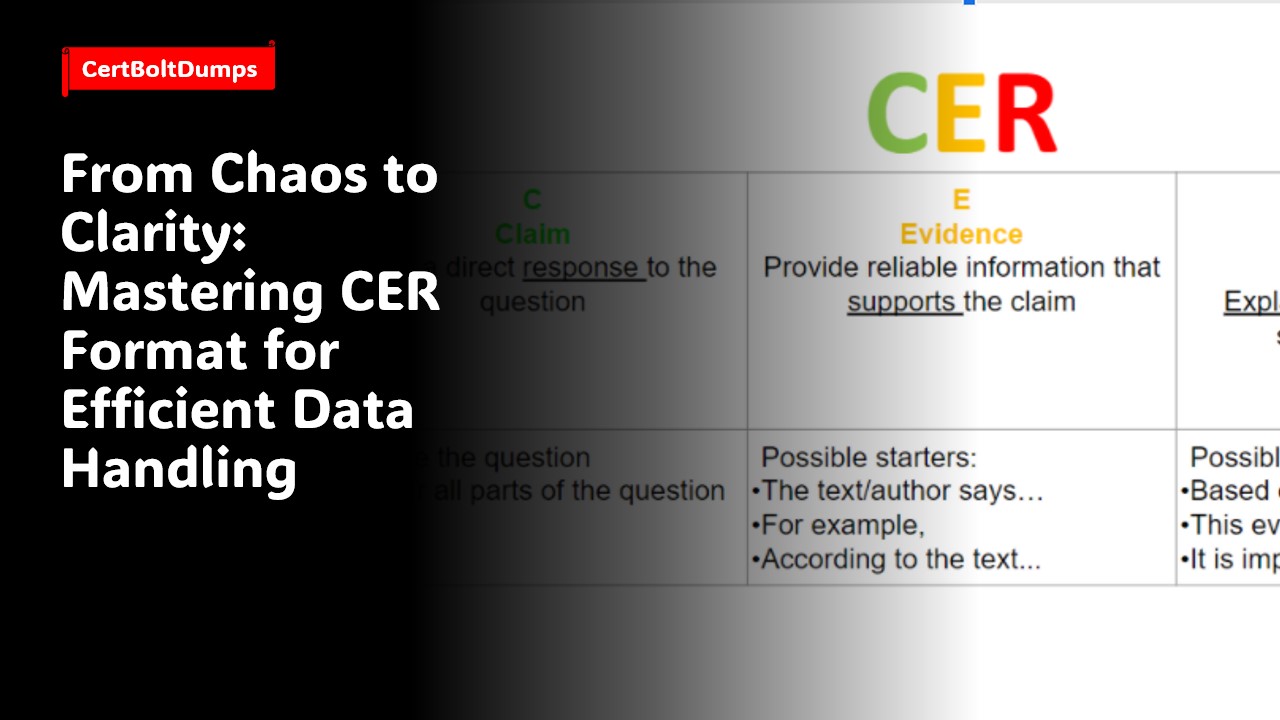In today’s digital age, unlocking data’s potential is essential to decision-making and business growth. However, when data grows in volume and complexity, maintaining and organizing it can feel like untangling a web. CER format is a powerful tool that collects and clarifies data processing.
CER Format
This blog article will cover the CER format and how mastering it may transform your data management. We’ll help you manage your precious information, from analyzing its importance to designing a practical form. Grab your notepads—we’re going from chaos to clarity!
Understanding Data Handling Importance
Any organization relies on data for insights and decision-making. This quantity of information can soon become overwhelming and unmanageable without adequate handling. Knowing data handling’s relevance is vital.
Efficient data management ensures correctness and reliability. When handling vast amounts of data, errors and inconsistencies are inevitable. Organizations can reduce these risks and maintain data accuracy by utilizing standardized formats like CER (which we’ll discuss later).
Organized data is more accessible to analyze. Searching through a messy pile of documents for specific information would be time-consuming and annoying! However, you can find what you need in seconds with adequately categorized and structured data in CER.
Additionally, reasonable data-handling procedures improve teamwork. Communication is more accessible when everyone can access well-structured, consistent material like CER. Collaboration across departments or organizations on joint projects is encouraged.
Finally (for now), good data management ensures regulatory and industry compliance. GDPR requires organizations to store and protect personal data securely. Using sturdy systems to organize sensitive information in CER forms helps with compliance and develops trust with customers who entrust your company with their data.
Finally, proper data handling is essential for successful corporate operations in today’s digital world.
Why is the CER Format Important?
Any company’s success depends on data management. Data is collected, organized, and analyzed to provide insights. The CER (Context, Event, Response) format is essential for effective data management.
CER format organizes event and incident data. Context, event, and response make up its core. Organizations can ensure data management uniformity, clarity, and correctness by using this format.
Why is the CER format important? Imagine managing piles of unorganized data across systems. Like looking for a needle in a haystack! The CER format standardizes data recording and storage, bringing order to chaos. This simplifies information retrieval and analysis for informed decision-making.

The CER framework also encourages organizational responsibility and openness. This format makes tracking individual or team activities easy when incidents are documented consistently.
The CER format improves data handling efficiency in an organization’s internal processes and allows coordination with external stakeholders like regulators and auditors. Having well-structured data makes reporting easy and boosts credibility.
CER format creation: how? Our next blog post will provide practical CER template creation recommendations!
Remember that mastering data structure is about giving your organization precise insights that fuel success, not merely being organized!
CER Format Creation: How?
Effective data management requires CER Formatting. Follow these steps for clarity and organization:
1. Establish Structure: Determine the essential CER elements. This may comprise variables, measurements, and dataset-specific criteria.
2. Standardize Naming: Create a CER file and folder naming convention. It will be easy to find and use data.
3. Choose Data Entry Methods: Choose manual or automatic data entry into the CER Format using APIs or scripts. Think about your ideal software or tools.
4. Use Descriptive Labels: Label and describe each CER Format item. This ensures understanding for you and others needing to view or analyze the data later.
5. Include Metadata: Include the creation date, author name, version number, and any citations or references with each dataset in your CER Format.
6. Validate Data Integrity: Regularly check your CER datasets for discrepancies and errors.
7. Backup Your Data: Use cloud-based or physical discs to back up CER Format data routinely.
Following these recommendations, establishing a CER format will organize data handling chores and improve accuracy and clarity.
CER Data Organization and Maintenance Tips
1. uniform Naming Conventions: CER data requires uniform file naming. This will simplify finding and retrieving information. Consider adding date, project name, or category to file names.
2. Structure of Folders: Store CER files in logical folders in your document management system. Sort related files into relevant directories. This keeps things organized and makes navigation easier.
3. Metadata Tagging: Label CER format files by department, customer name, or project type using metadata tagging. This speeds up information retrieval by filtering by tags.
4. Version Control: Track CER format file changes with a version control system. Mark file versions with dates or revision numbers to readily identify the latest version.
5. Regular Backups: Backup your CER format files to external discs or online storage to avoid data loss. Automatic backups can help you always retain vital data.
6. Data Security: Encrypt or password-protect CER data to prevent unauthorized access.
7. Routine Maintenance: To detect errors, inconsistencies, duplication, and outdated CER data, do frequent maintenance checks.
Following these suggestions for organizing and preserving CER data properly helps streamline workflows, optimize productivity, and promote communication among team members who use this information while decreasing mismanagement risks.
CER Format Data Handling Benefits
Today’s fast-paced digital environment requires efficient data handling. Businesses and organizations need a structured data management strategy due to the exponential growth of information. The CER format applies here.
Data is organized and maintained using the CER format, which is short for Create, Edit, and Review. By using this format, you can keep your data correct, current, and accessible.
Efficiency is a significant benefit of CER. A standardized data processing process streamlines workflows and eliminates duplicate jobs. The clear organization in CER makes complex datasets easy to navigate.
The CER format improves teamwork. A uniform framework helps data management teams understand their roles and responsibilities. This enhances collaboration and reduces communication errors.
The CER aids compliance and audits. As data privacy requirements tighten, transparent documentation of data handling throughout its lifecycle is crucial. The CER provides an audit trail for accountability and regulatory compliance.
Implementing the CER improves decision-making by providing trustworthy insights from organized data sets. With well-structured data, you can make faster business choices and reduce risks from unreliable or incomplete datasets.
As instructed, understanding the CER format provides many benefits for efficient data management in organizations across industries. This organized strategy may turn chaotic datasets into valuable assets that drive success in today’s digital landscape by improving productivity, collaboration, compliance, and decision-making.
Success Stories of CER Format Implementation

1. Healthcare: CER has been very effective in the healthcare business. This format can organize and make patient information, medical history, test findings, and treatment plans accessible in hospitals and clinics. This gives doctors and nurses all the information they need to provide care.
2. Research Institutions: They handle massive volumes of data from experiments and studies. Researchers can efficiently categorize and analyze data using CER. This improves teamwork and research efficiency.
3. Financial Sector: Banks and financial organizations process many daily transactions. A CER format lets them securely store account details, transaction history, and loan applications for easy retrieval.
4. Tech Companies: Product development and troubleshooting require data management. By organizing user comments and bug reports in a CER manner, they can easily spot trends and issues.
5. Education: CER forms help schools organize student grades, attendance, and extracurricular activities.
Teachers can correctly track student progress with quick access to this information. These real-world examples show how diverse sectors have used CER for efficient data processing.
Structured data helps organizations make informed decisions based on reliable insights, improving efficiency and performance.
Attendance Accuracy Matters for Decision-MakingCommon CER Format Issues
CER is a sophisticated data handling format, yet it has some drawbacks. Format setup and creation are regular challenges. It takes effort and planning to provide all the necessary facts.
Maintaining CER format uniformity between datasets or projects is another difficulty. Team members may need help understanding and using the format differently, causing data organization problems.
As data grows, updating the CER might take time and effort. It needs constant monitoring and updating to reflect dataset changes and additions.
Managing significant amounts of data in CER format might take time. More extensive databases make it harder to navigate and extract valuable data.
Integrating data from diverse sources into the CER format may also offer compatibility difficulties that must be resolved before smooth integration.
Securely handling sensitive CER data is necessary but difficult. Proper access controls and encryption are needed to safeguard confidential data.
Despite these hurdles, understanding CER for effective data processing improves organization, accessibility, team cooperation, and accurate analysis-based decision-making.
Data workers can improve process efficiency and uncover valuable insights from their datasets by planning, fixing compatibility concerns, and implementing strong security measures.